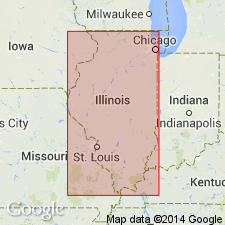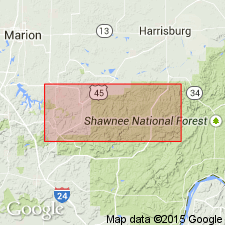
- Usage in publication:
-
- Gentry coal member
- Modifications:
-
- Original reference
- Dominant lithology:
-
- Coal
- AAPG geologic province:
-
- Illinois basin
Summary:
Pg. 29, 44 (table 1), 61, pl. 1. Gentry coal member of Caseyville formation of McCormick group (new). Overlies Sellers limestone member; underlies Pounds sandstone member. Thickness 2 feet in type section of Caseyville. Owen (1856) termed this Battery Rock coal, but Battery Rock has been more widely used for the sandstone and is so restricted in this report. Age is Pennsylvanian. Presentation of new rock-stratigraphic classification of Pennsylvanian of Illinois. Cyclical classification is retained but is entirely independent of rock-stratigraphic classification.
Type locality: in sec. 26, T. 11 S., R. 10 E., southwestern Hardin Co., southeastern IL.
Source: US geologic names lexicon (USGS Bull. 1200, p. 1494).

- Usage in publication:
-
- Gentry Coal Bed
- Modifications:
-
- Revised
- AAPG geologic province:
-
- Illinois basin
Summary:
Rank of the Gentry Coal here changed from member to bed and unit assigned to the base of the Drury Member of the Caseyville Formation. Change in status based on its limited extent. [Widely continuous coals in this study are designated members, while local or lenticular coals are designated beds.] The Gentry has been identified in parts of Hardin Co., IL, and Crittenden and Livingston Cos, KY (where it is considered an informal term). The Gentry of this study is in the same stratigraphic position as the type Gentry and is similar in palynological content though it is not traceable from one site to the other. The best exposures in the study area are in railroad cuts in the southwestern part of the Stonefort quad. Thickness ranges from 14 to 24 in. Coal is described as very shaly except for the uppermost 4 to 6 in., which is brightly banded. Occurs 3 to 10 ft above the top of the Battery Rock Sandstone Member. Intervening strata is soft shale and claystone.
Source: GNU records (USGS DDS-6; Reston GNULEX).
For more information, please contact Nancy Stamm, Geologic Names Committee Secretary.
Asterisk (*) indicates published by U.S. Geological Survey authors.
"No current usage" (†) implies that a name has been abandoned or has fallen into disuse. Former usage and, if known, replacement name given in parentheses ( ).
Slash (/) indicates name conflicts with nomenclatural guidelines (CSN, 1933; ACSN, 1961, 1970; NACSN, 1983, 2005, 2021). May be explained within brackets ([ ]).

